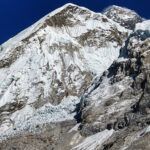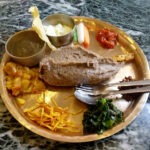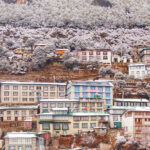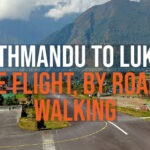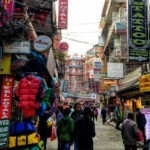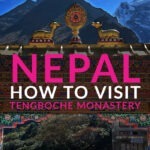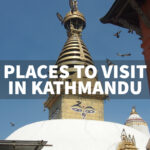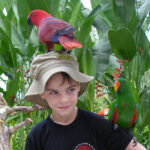The classic Everest Base Camp trek in Nepal follows the itinerary below. If you book a guided group trek to hike to Everest Base Camp, this will be your route and schedule, with some groups having slight variations. However, if you trek independently, you can change this itinerary in any way you choose. You don’t even have to fly to Lukla, you can walk to Lukla and there are other villages with accommodation along the EBC route. There are several possible variations on this trek.
In this post we’ll give you the normal EBC schedule, share photos of each place, and give you some alternatives. We also tell you how and where to book a trek. (spoiler – book a trek here)
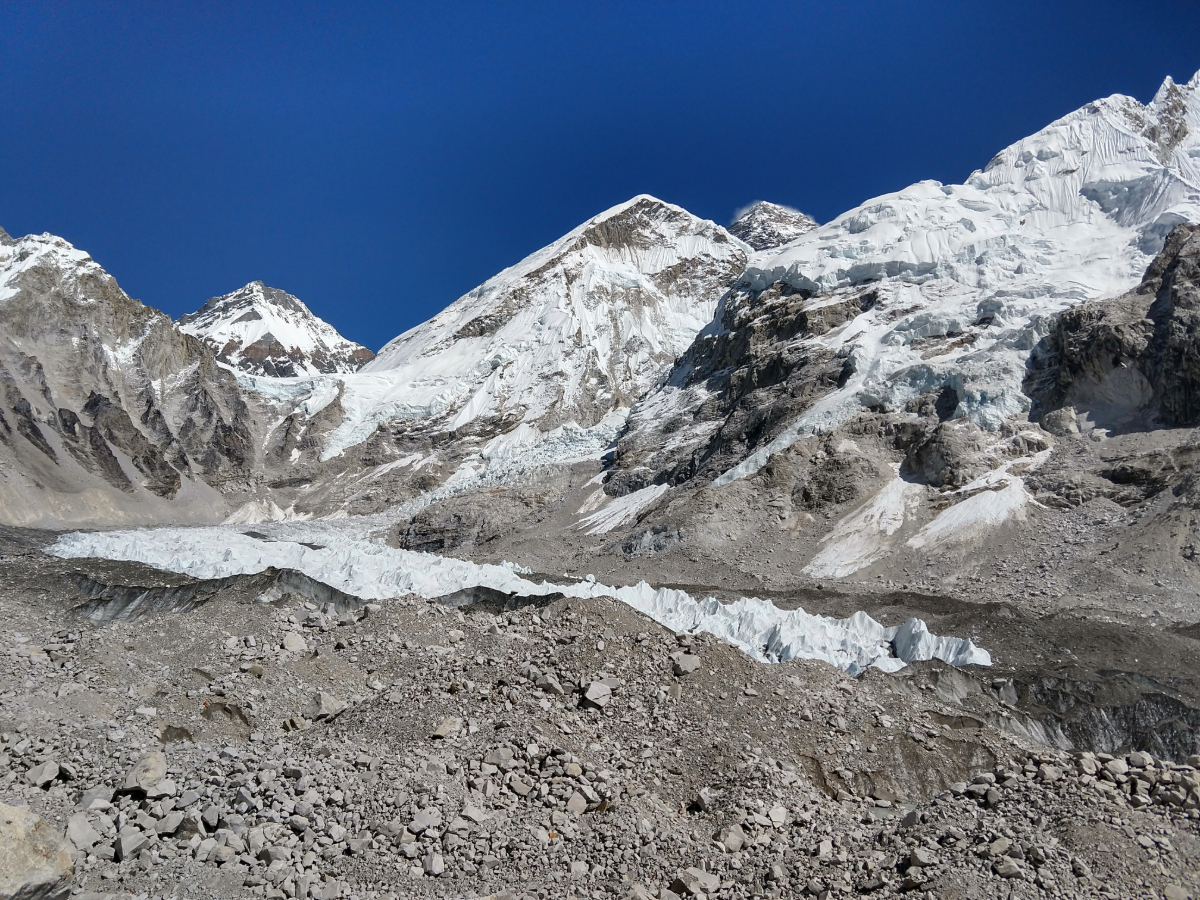
In our opinion, the Everest Base Camp Trek is suitable for beginners. It’s only hard because of the lack of oxygen and nobody can train for that. We’ve taken our kids to Base Camp. If you’re an inexperienced traveller and haven’t spent time in Asia or in very rural parts of the world with few facilities, maybe it is not for you. Don’t expect luxury, the lodges are very basic. But walking is just walking. If you can walk for 5 hours, you should be fine.
If you get out of breath walking up stairs you’ll struggle. But the good news is you get fitter as you walk.
At Base Camp, Gorak Shep and Kala Patthar, you will only have about 50% of the oxygen you normally have at sea level. Every step will leave you breathless, you may have trouble sleeping and you’re very likely to get sick. These factors and the very basic food and lodging, are what cause difficulties for most people on the EBC trek.
Our realistic EBC packing list is here.
Classic Everest Base Camp Trek Itinerary
Day 1. Fly from Kathmandu to Lukla, walk to Phakding.
Day 2. Walk from Phakding to Namche Bazaar.
Day 3. Acclimatisation day in Namche Bazaar.
Day 4. Walk from Namche Bazaar to Tangboche.
Day 5. Walk from Tangboche to Dingboche.
Day 6. Acclimatisation day in Dingboche
Day 7. Walk from Dingboche to Loboche.
Day 8. Walk from Loboche to Gorak Shep.
Day 9, Climb Kala Patthar and continue to Everest Base Camp, returning to Gorak Shep.
Days 10 to Day 15, make your way back to Lukla and fly back to Kathmandu.
How Much Extra Time To Spend in Nepal? (&costs)
How To Book a Trek
Day 1. Fly from Kathmandu to Lukla, walk to Phakding
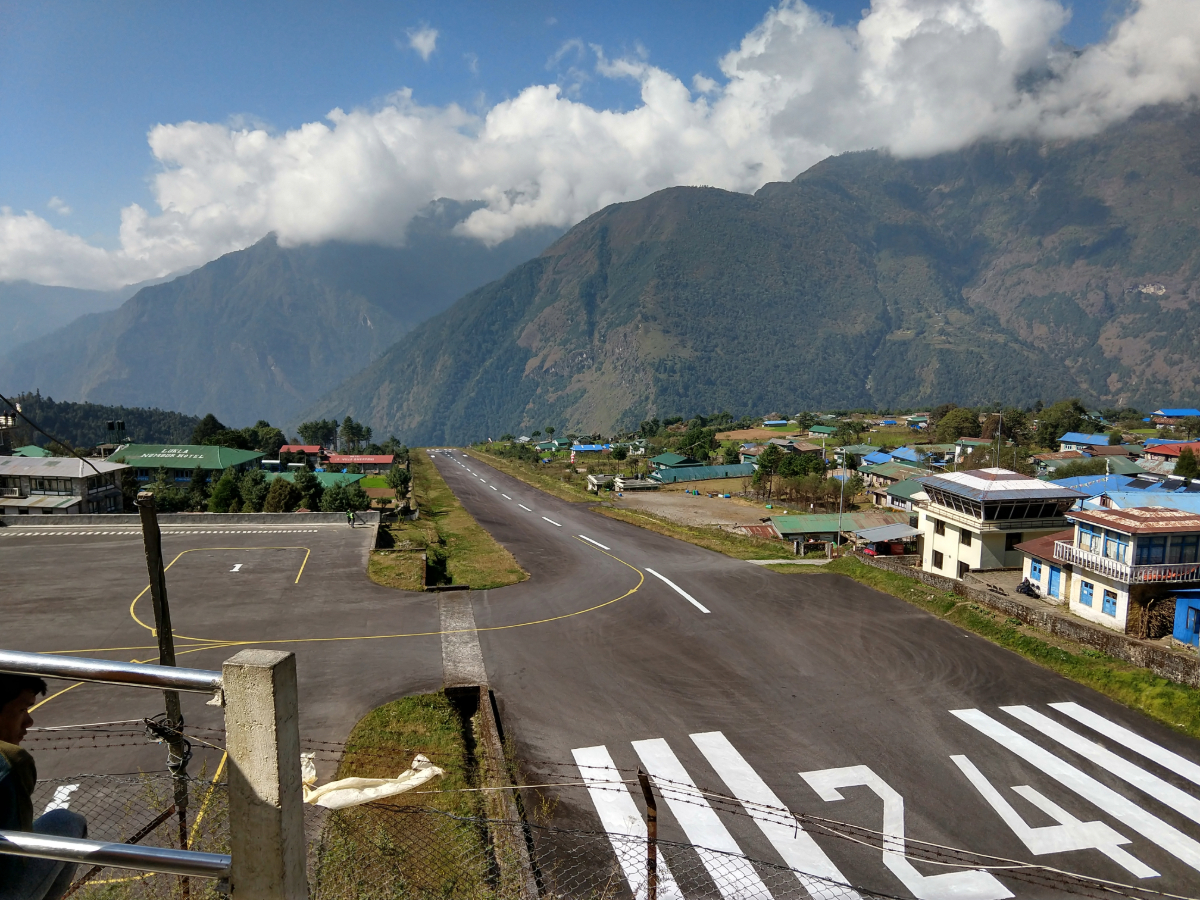
Day 1 of the Everest Base Camp trek is easy, so long as you don’t develop an instant altitude headache when you get off the plane in Luka.
Day one is downhill so as you walk you’ll be losing altitude and your headache will hopefully go away.
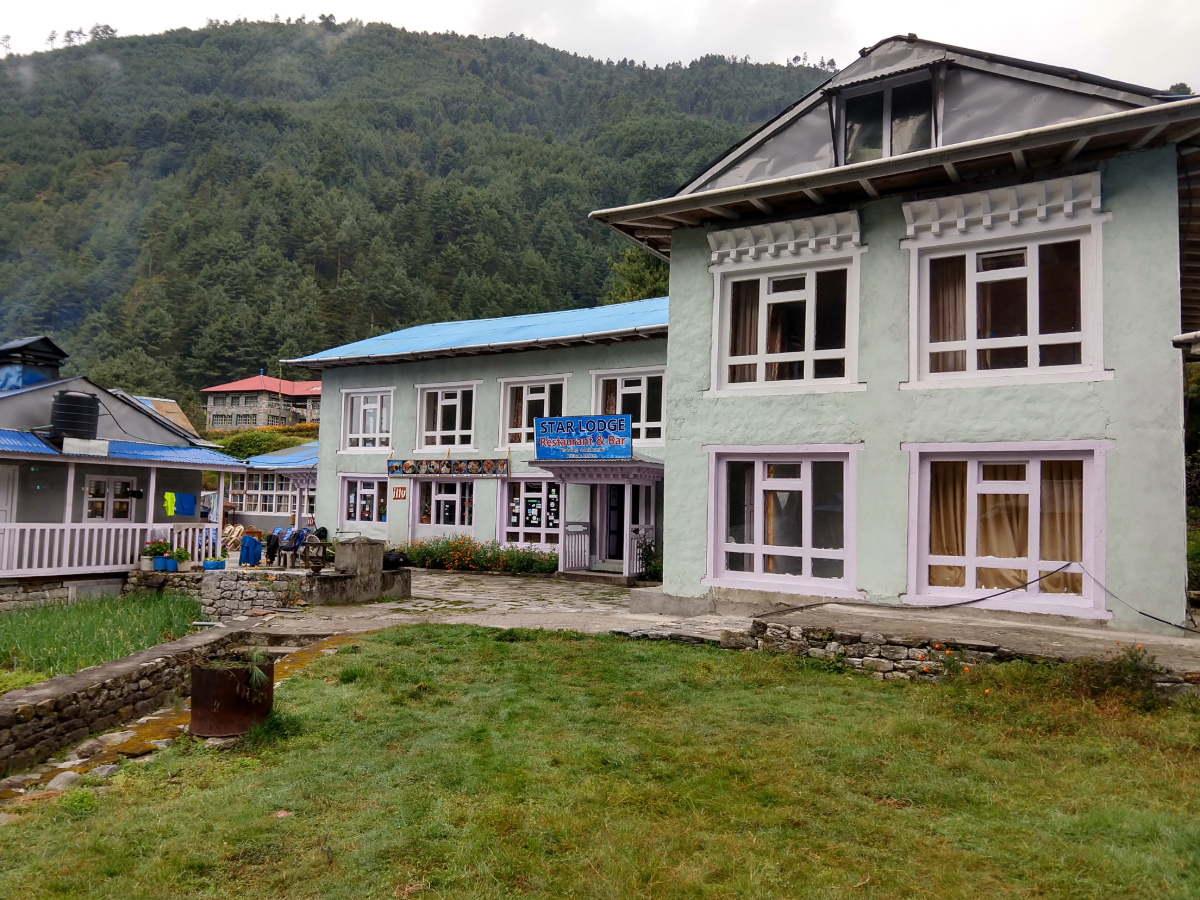
You actually descend about 200m between Lukla and Phakding, which is at the bottom of a valley. Theres not much I can say about Phakding, it’s just a place to sleep.
Lukla altitude 2,840m, Phakding altitude 2,610 m. Walking distance 6.2 Km, walking time about 3 hours.
We’ll give you these figures as an idea, but obviously, you may walk faster or slower, take more breaks etc. Please double check everything. I’m taking these altitudes off a T shirt I bought up there.
Day 2. Walk from Phakding to Namche Bazaar.
Day 1 may have lulled you into a false sense of security. Day 2 of the Everest Base Camp trek is hard, you have to climb Namche Hill and gain 800m. You also have to cross the scariest suspension bridge of the trek.
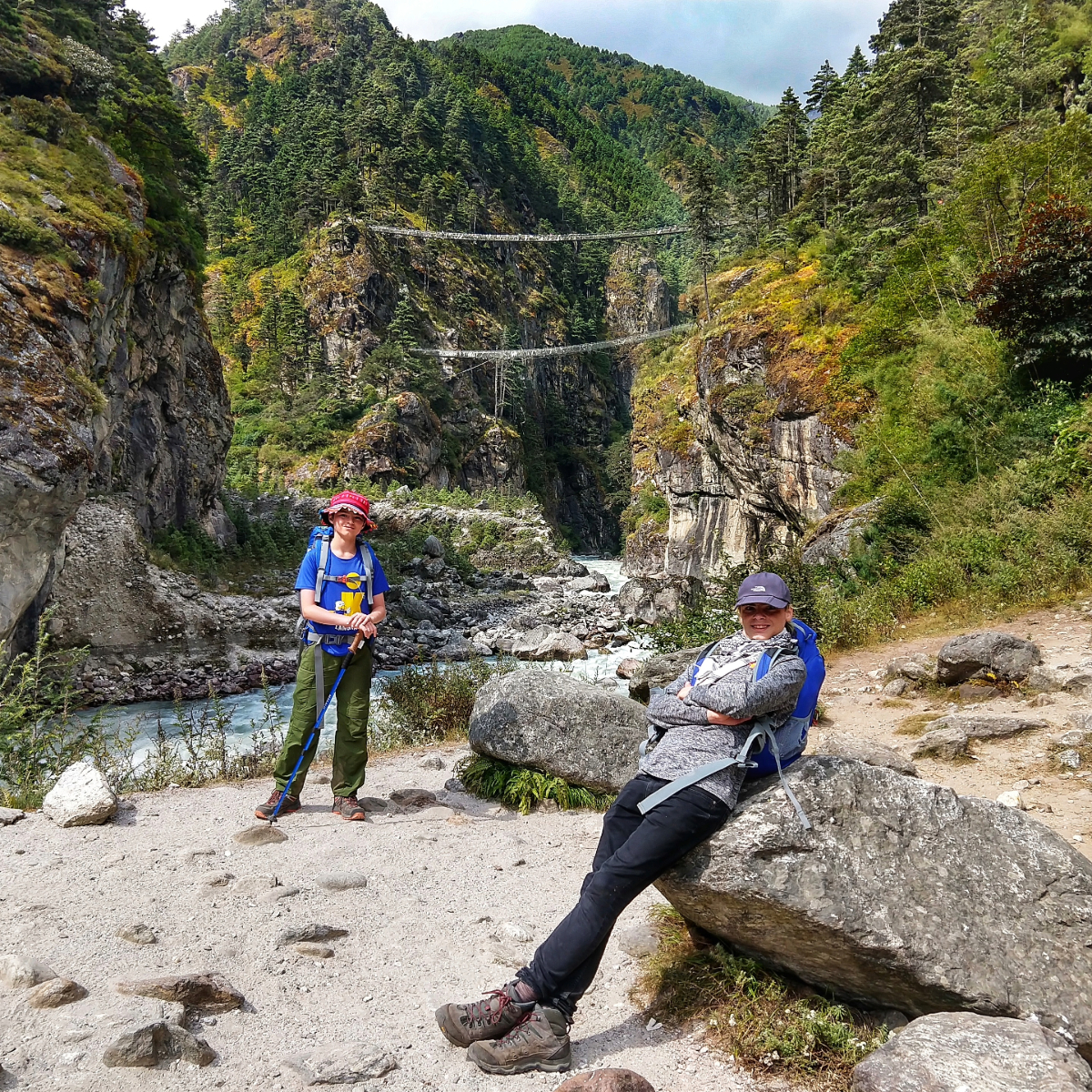
There are loads of bridges, but this one is really high. And you’ll be crossing it on the way back too.
There is an Everest view point as you approach Namche Bazaar.
Phakding altitude 2,610 m, Namche Bazaar altitude 3,440m, walking distance 9 km, walking time 5-6 hours.
Day 3. Acclimatisation day in Namche Bazaar.
Namche Bazaar is a really nice place. If you’re not on a tour group schedule we suggest you allow several days in Namche because it’s nice to just hang out here and see the sights.
It’s best to do this on your way down when you’ll be fully acclimatised and have a bit more energy. You can also have a beer or two at the Irish Pub on the way down. I wouldn’t risk drinking alcohol on your way up.
We have a full post on things to do and see in Namche Bazaar here, I’ll also put it in the related post at the end of the page. You can buy just about anything you may need in Namche and prices aren’t too bad.
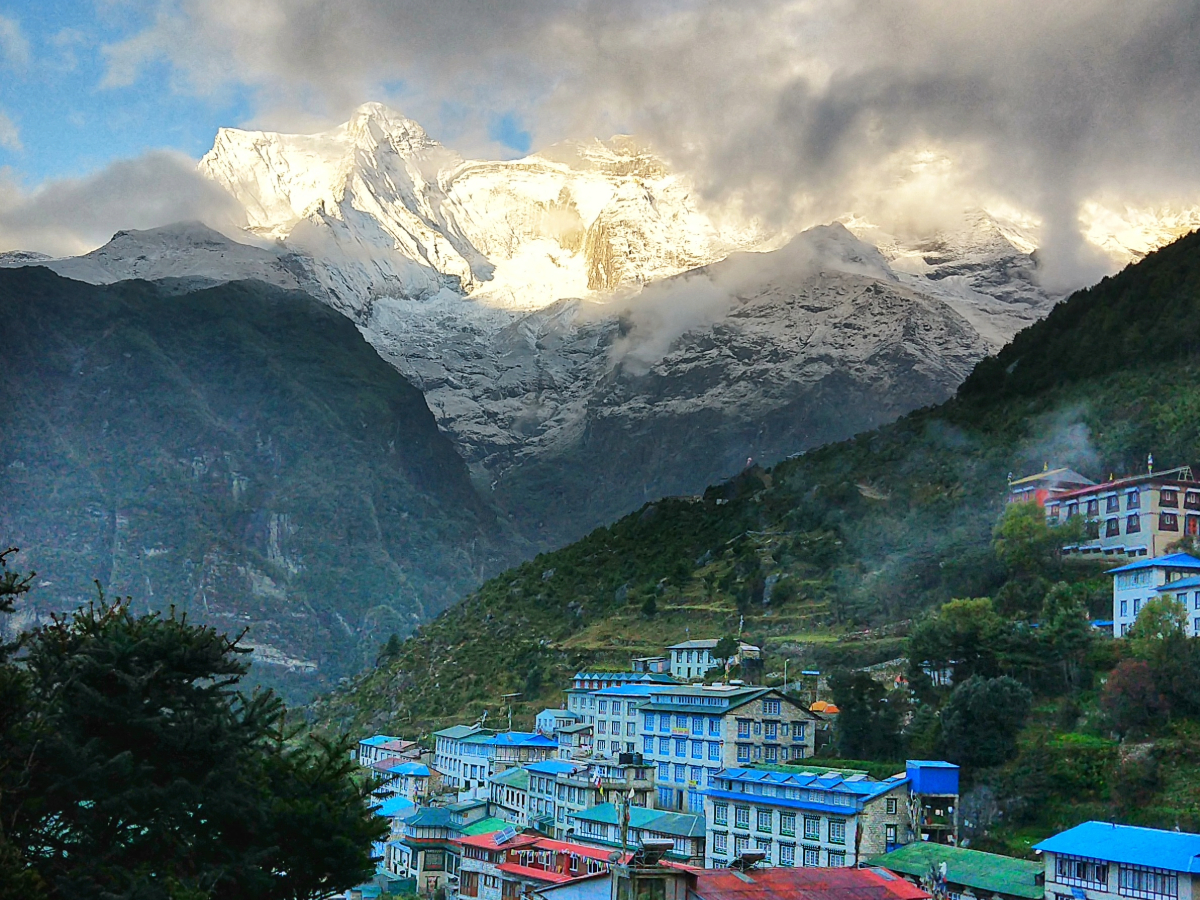
Above Namche Bazaar there is a good Everest view point, a small museum, and a statue of Tenzing Norgay. Don’t miss the chocolate cake at The German Bakery.
Your acclimatisation hike will be up to the Everest View Hotel and maybe the village of Khumjung. There is a yeti skull relic in the monastery here, we have a post about Khumjung and said yeti skull, yes, we’ve seen it.
Day 4. Walk from Namche Bazaar to Tangboche
If you go all the way to Tangboche (or Tengboche) from Namche Bazaar, it’s another tough day with Tangboche Hill coming at the end of the day.
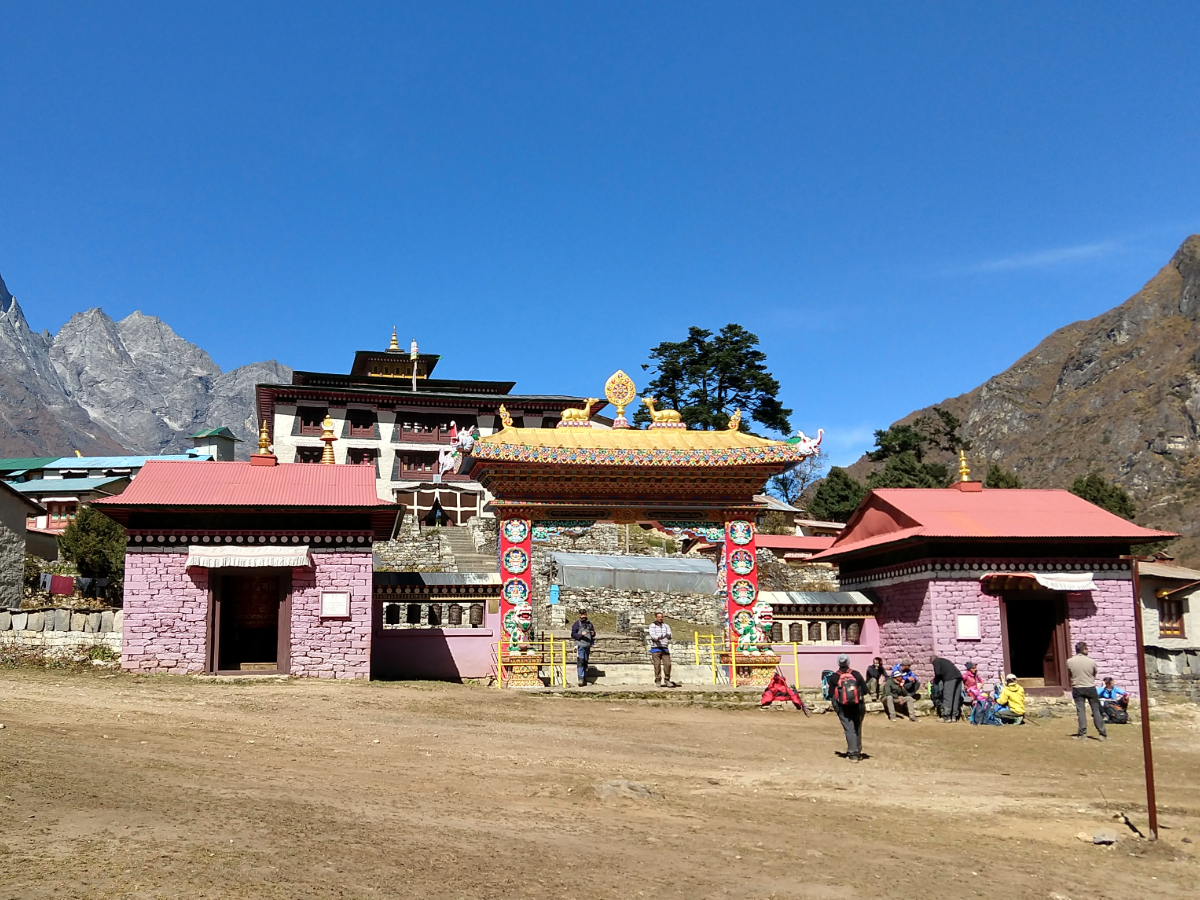
You will climb out of Namche Bazaar, past the Everest Lookout, and then skirt around the side of the mountain towards Tengboche. The trail is fairly flat until you drop right down into the valley at Phungi Thenga. There’s a good place to get a cup of tea just before the bridge.
Once you cross the bridge here you’re climbing, probably for about 2 hours. If you look at the photo below Tengboche is on the ridge in the centre of the photo. You can see Everest from Tengboche, and in this photo.
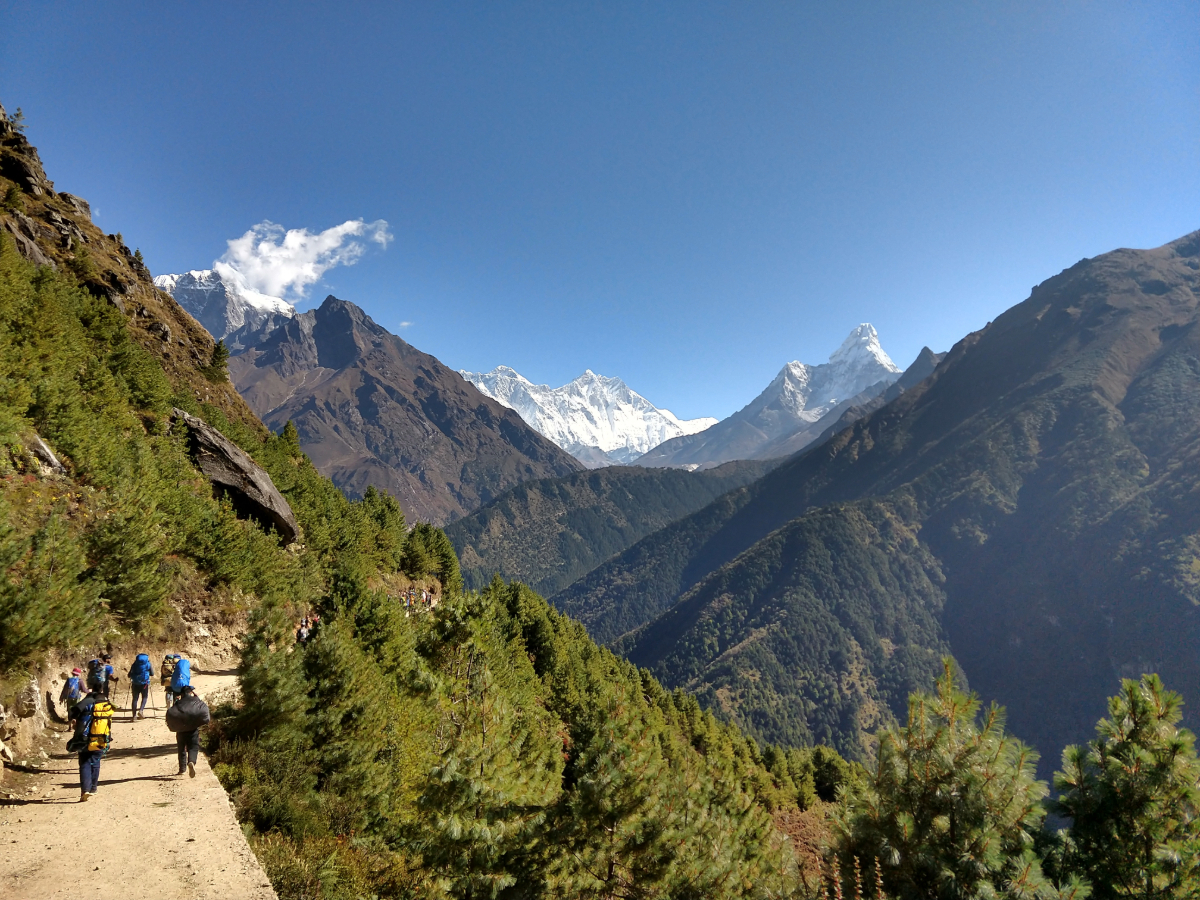
Despite the hill, Tengboche is one of my favourite places on the trek. Try to go inside the monastery and hear the monks chanting. You’ll need to take your boots off.
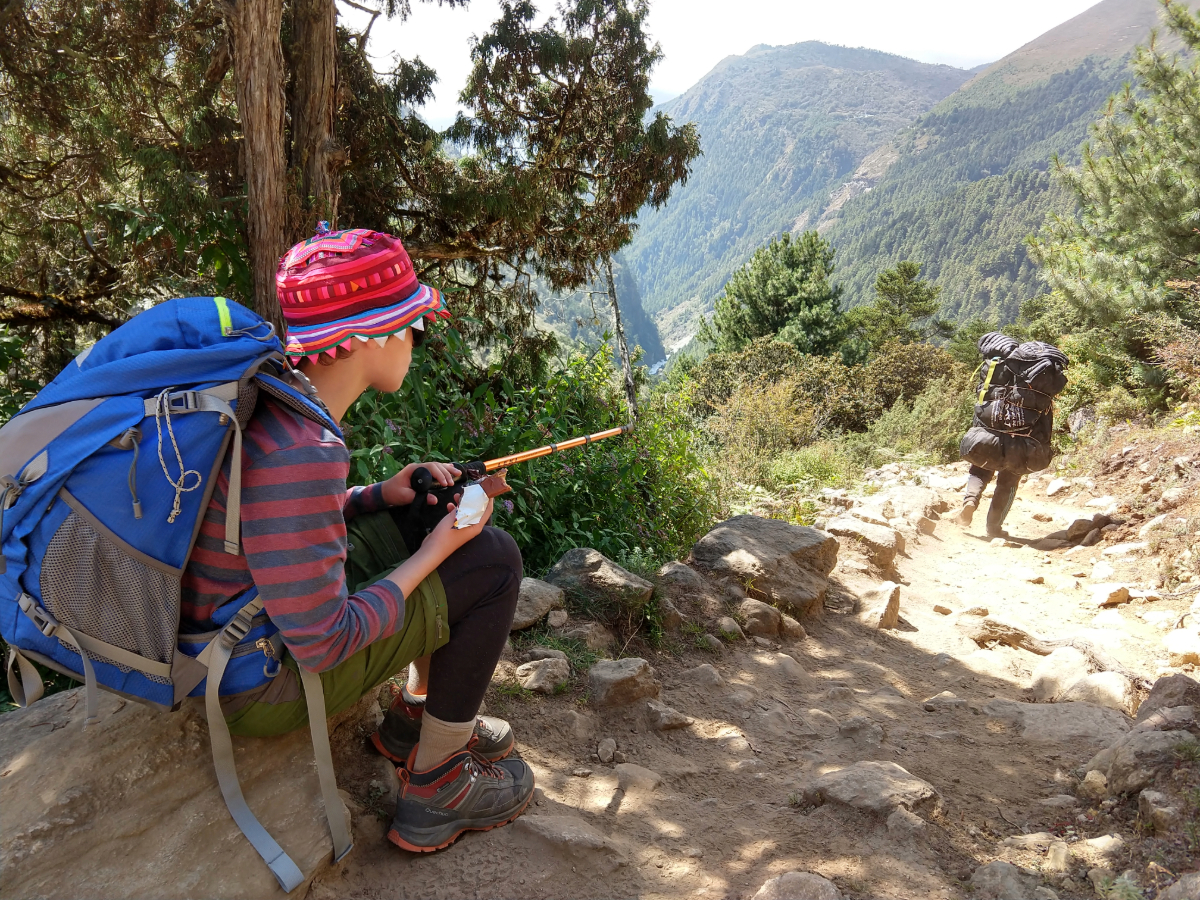
Namche Bazaar altitude 3,440m Tengboche altitude 3,870m, walking distance 9.2 km, walk time 5-6 hours.
Day 5. Walk from Tangboche to Dingboche
From Tengboche the trail is flat and forested for a while before opening out onto a plateau devoid of trees and divided up into fields by dry stone walls.
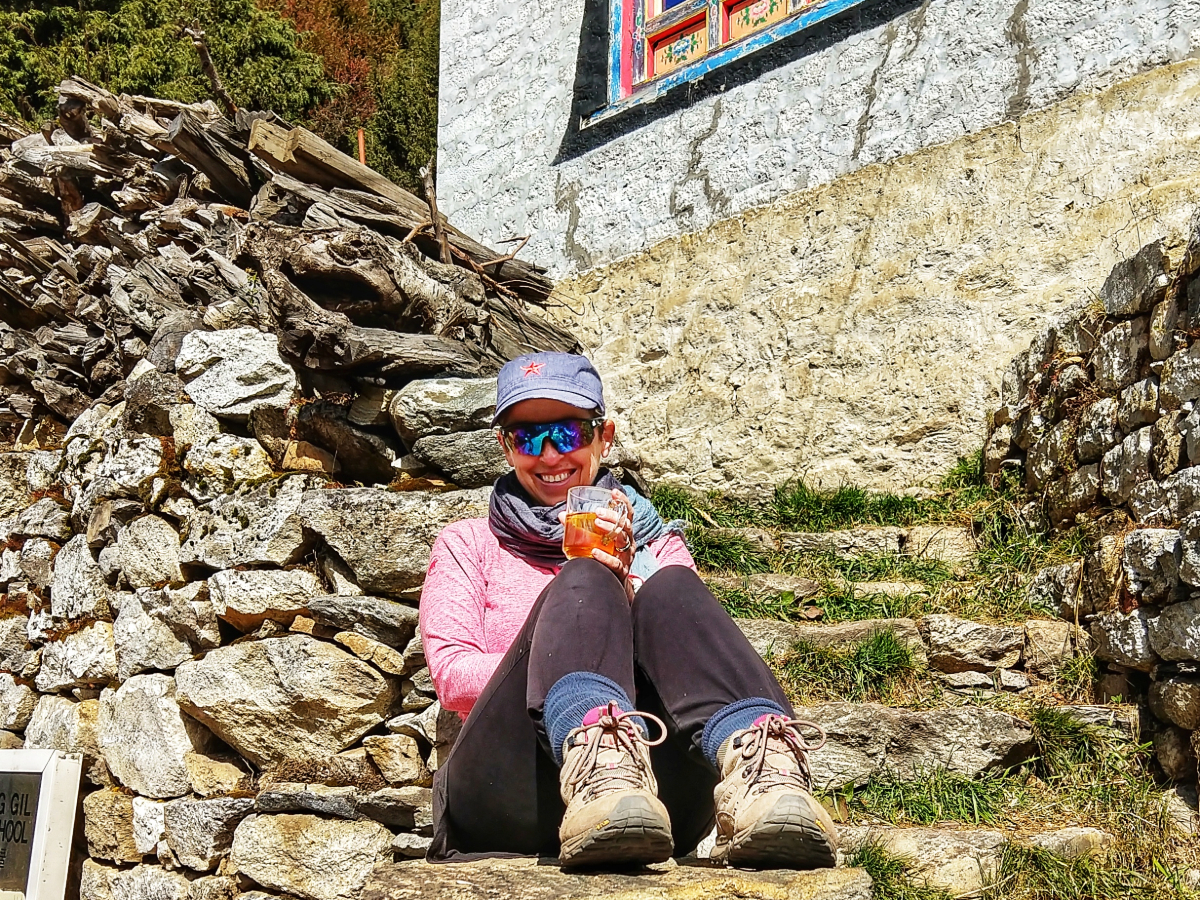
You’ll then find a rocky section and I think it was about here that I felt like giving up. But I didn’t.
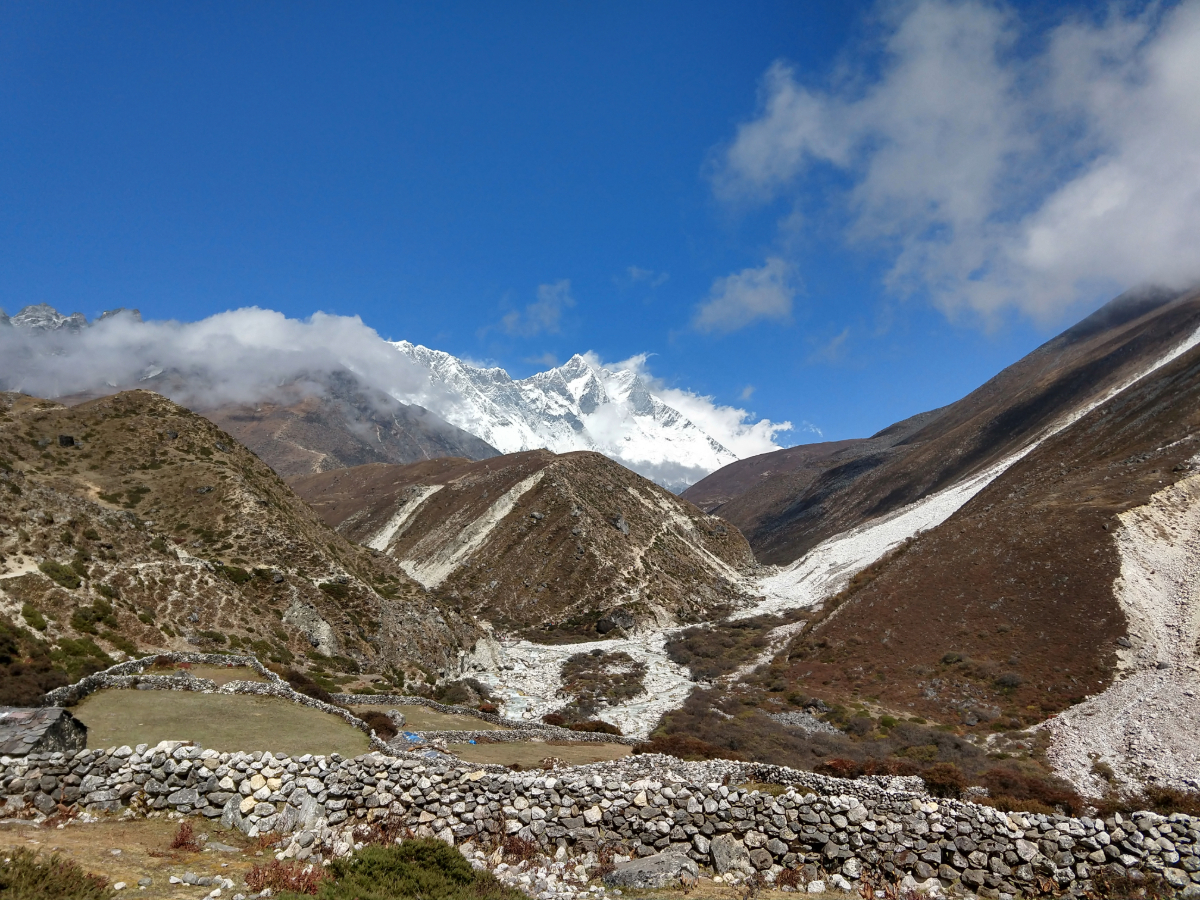
Tangboche to Dingboche is the longest distance walked on the Everest Base Camp trek and the only day where you walk over 10 km. I can run 10 km, so for me to be feeling like quitting when walking 10km shows how much the altitude affects you.
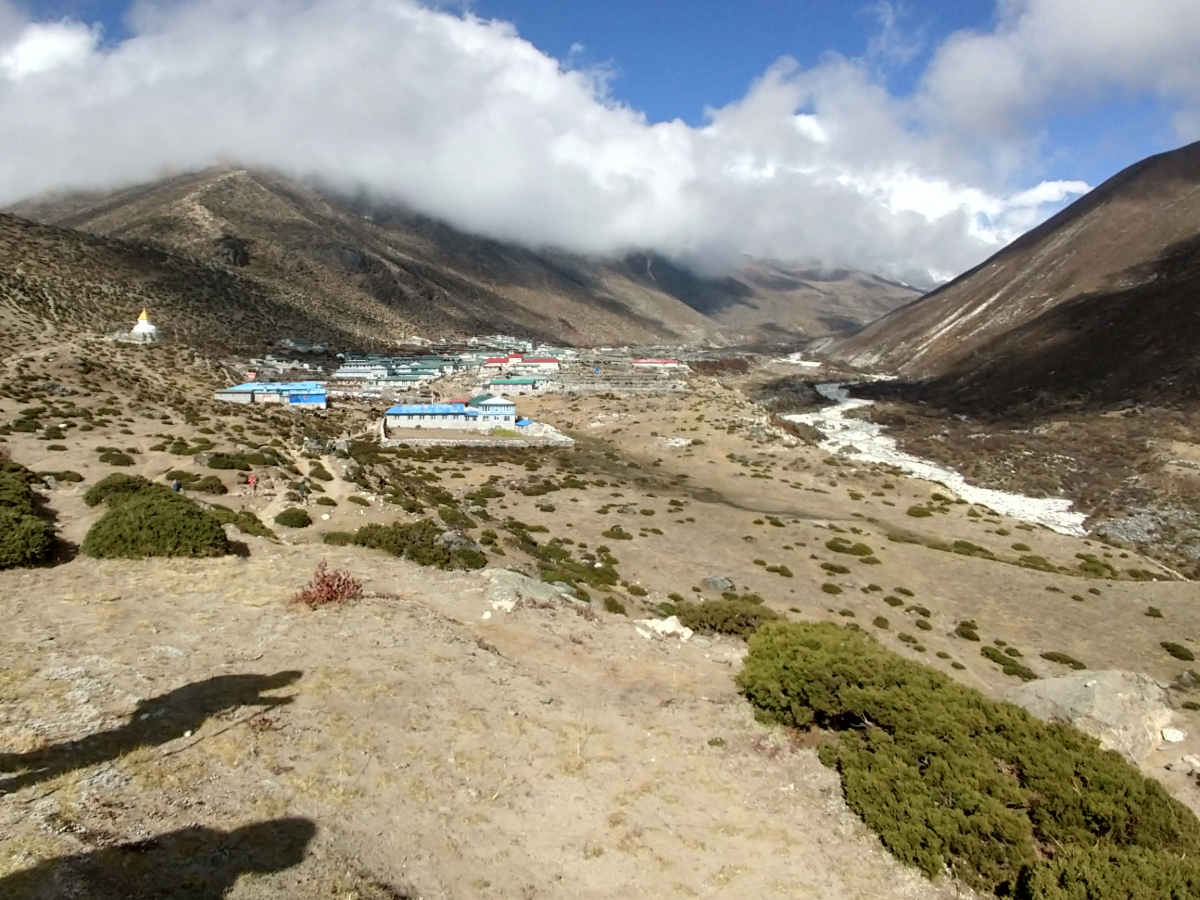
I was very glad to collapse in Dingboche when we arrived. The acclimatisation trek from Dingboche is up the mountain on the left. That’s also the path you’ll take the next day to Loboche.
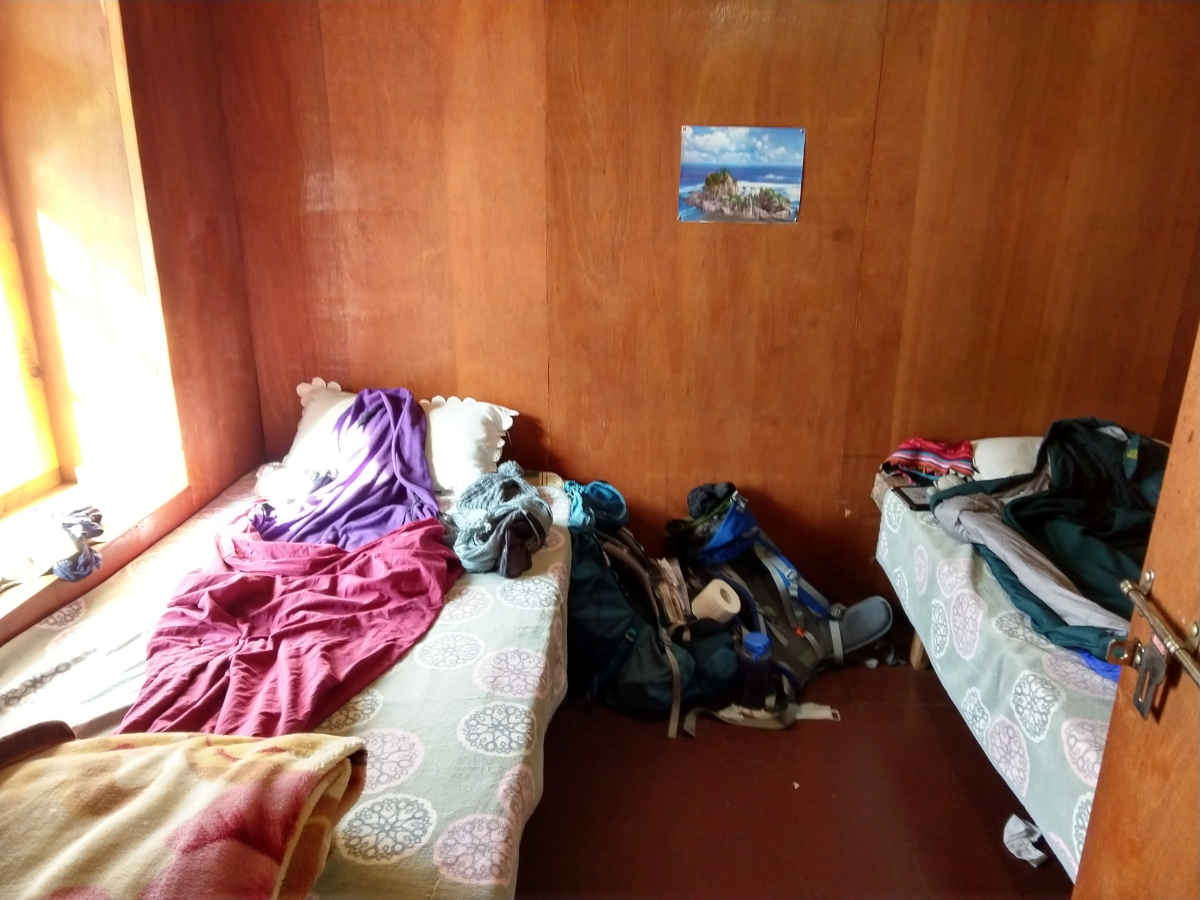
Tengboche altitude 3,870m, Dingboche altitude 4,410m, walking distance 10.5 km, walk time 6 hours
Day 6. Acclimatisation day in Dingboche
Dingboche is another place where you will do an acclimatisation walk to a greater altitude. The views are spectacular.
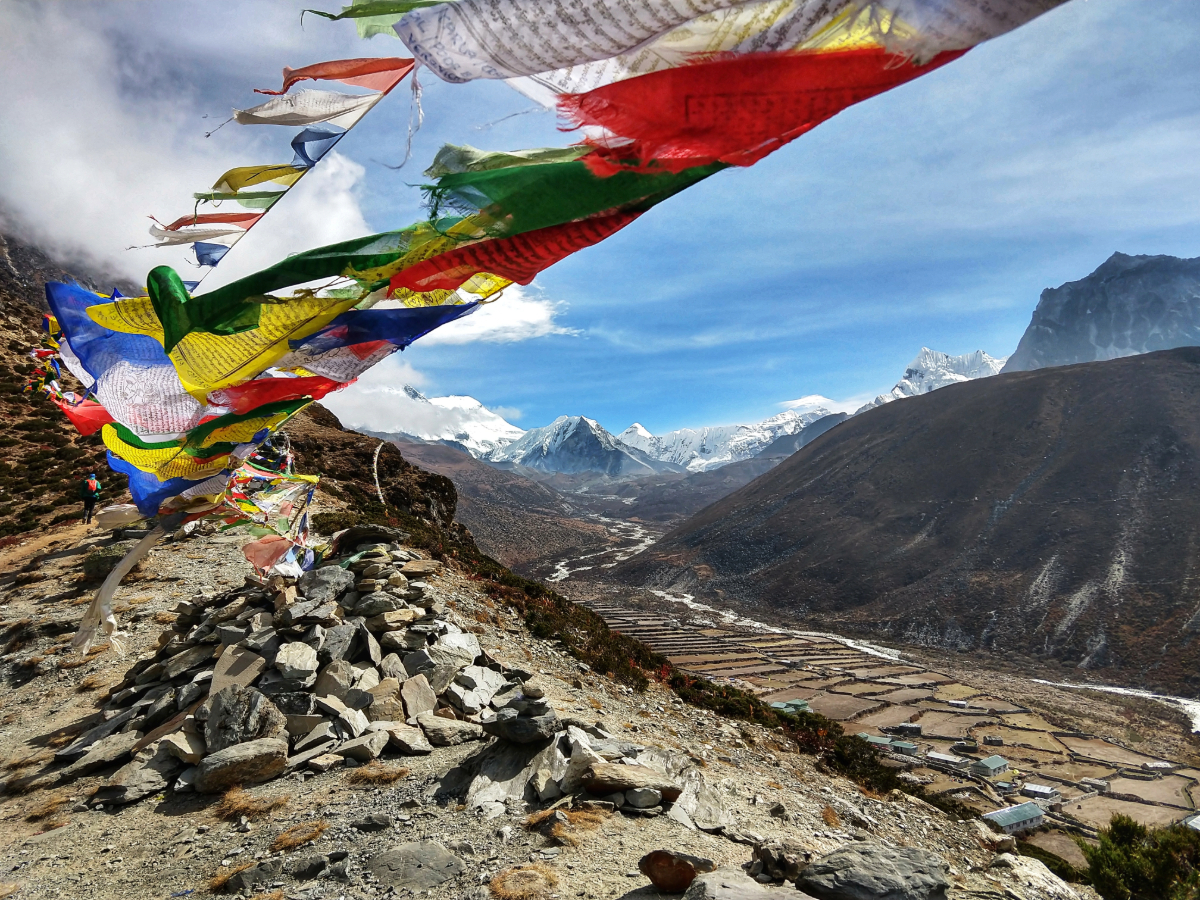
Dingboche is quite a big settlement with a few shops and restaurants. It’s not a town like Namche, but it’s large for these mountain settlements.
I think we found a bakery and had some tea and cakes in Dingboche. I tried to wash socks but they wouldn’t dry.
Day 7. Walk from Dingboche to Loboche.
You start your walk from Dingboche by reclimbing the hill you climbed yesterday. After that, it’s flat for a while with incredible views.
You will be able to see Periche in the valley below, if you choose to go back that way you’ll stop there.
There’s another steep hill to climb between Dingboche and Loboche and the altitude will really be making itself felt by now.
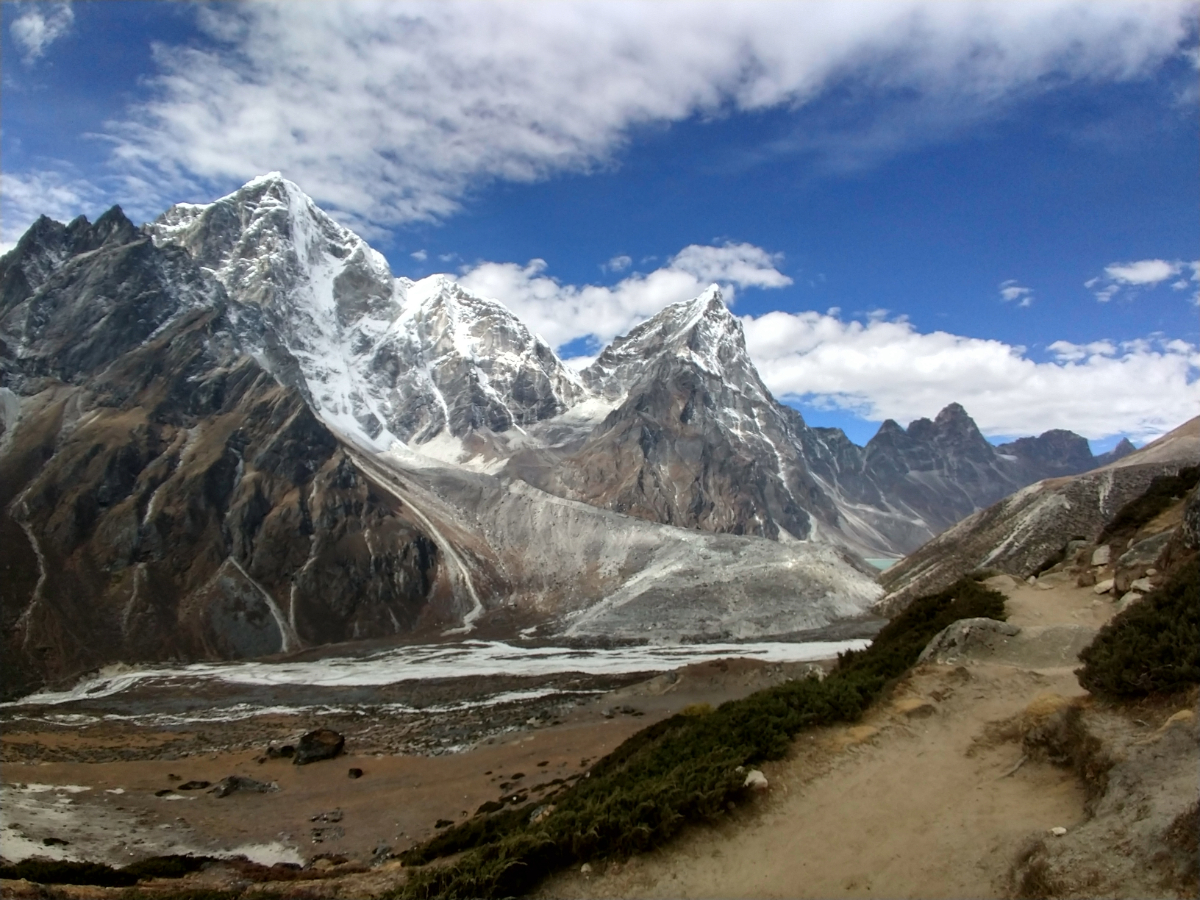
There are amazing views today and you will pass through the climbers memorials. This is where Scott Fisher’s memorial is. It’s not his grave, he was never buried, his body is still on Mount Everest.
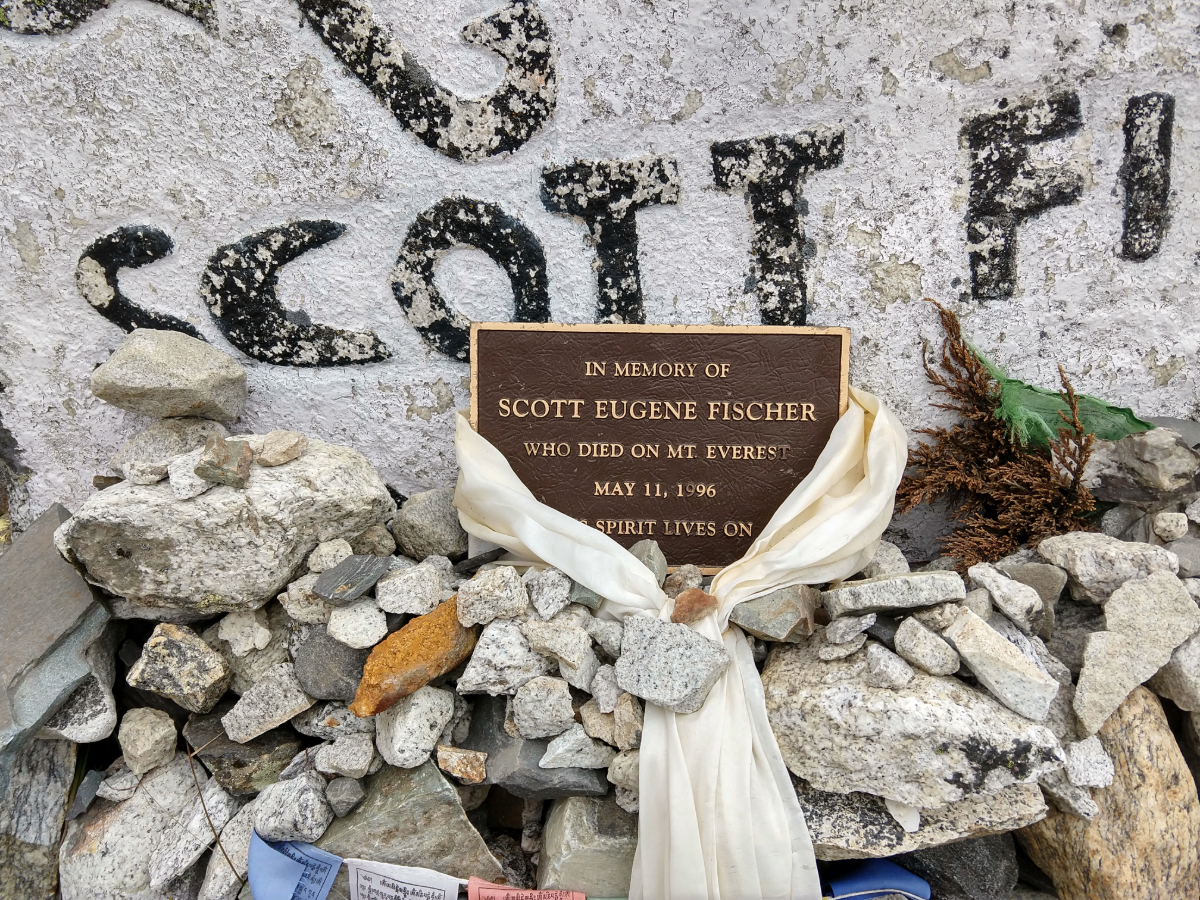
There are multiple memorials here and you should take a while to read them. It’s a haunting spot, just at the top of the hill.
From here it’s fairly flat to Loboche.
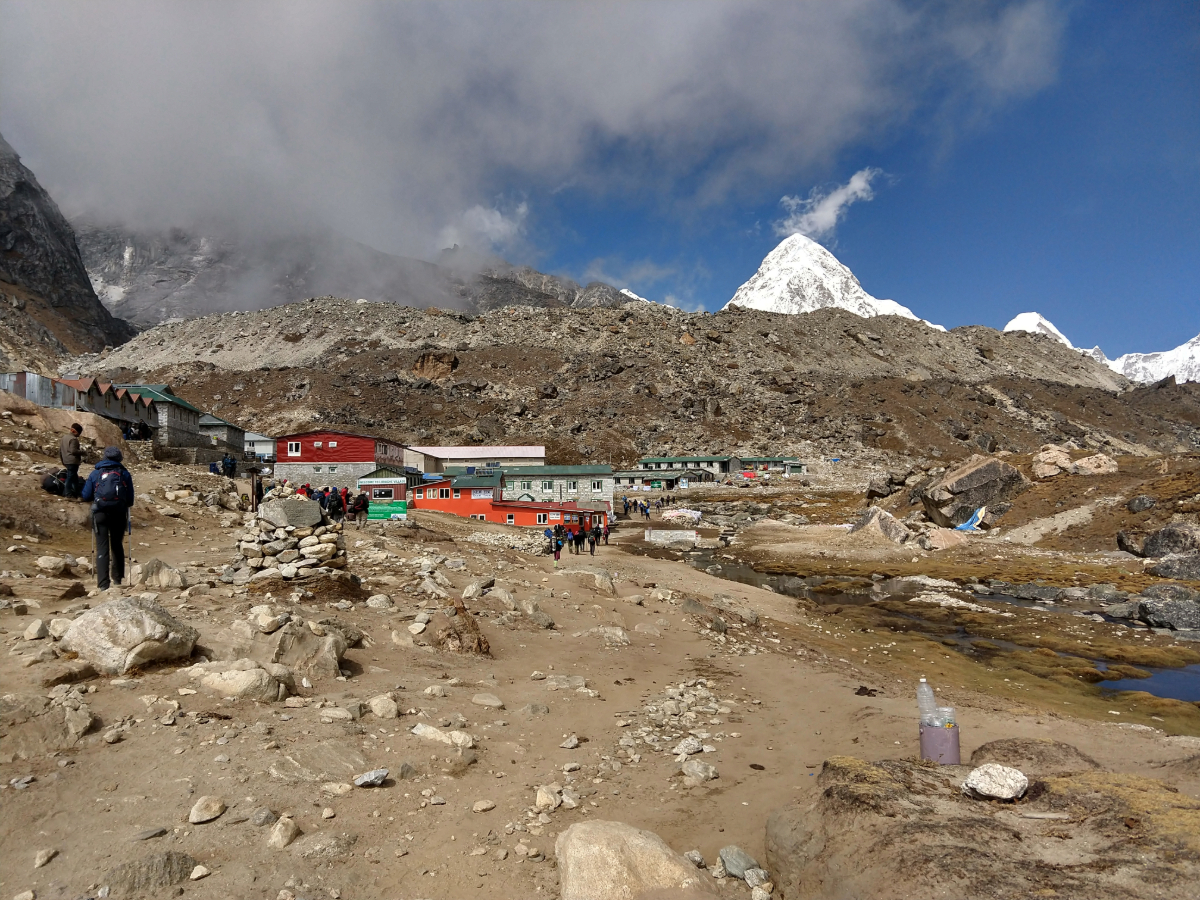
There is really nothing in Loboche other than a few guest houses. We met a nice chap called Alistair here and I gave him my spare sunglasses. He’d lost his, that’s a surefire way to get snow blindness. We saw somebody get that on the Annapurna trek. He was a nurse and had spare paracetamol for the flu we were all developing.
Dingboche altitude 4,410m Loboche altitude 4,910m walking distance 8.4 km walk time 5 hours.
Day 8. Walk from Loboche to Gorak Shep.
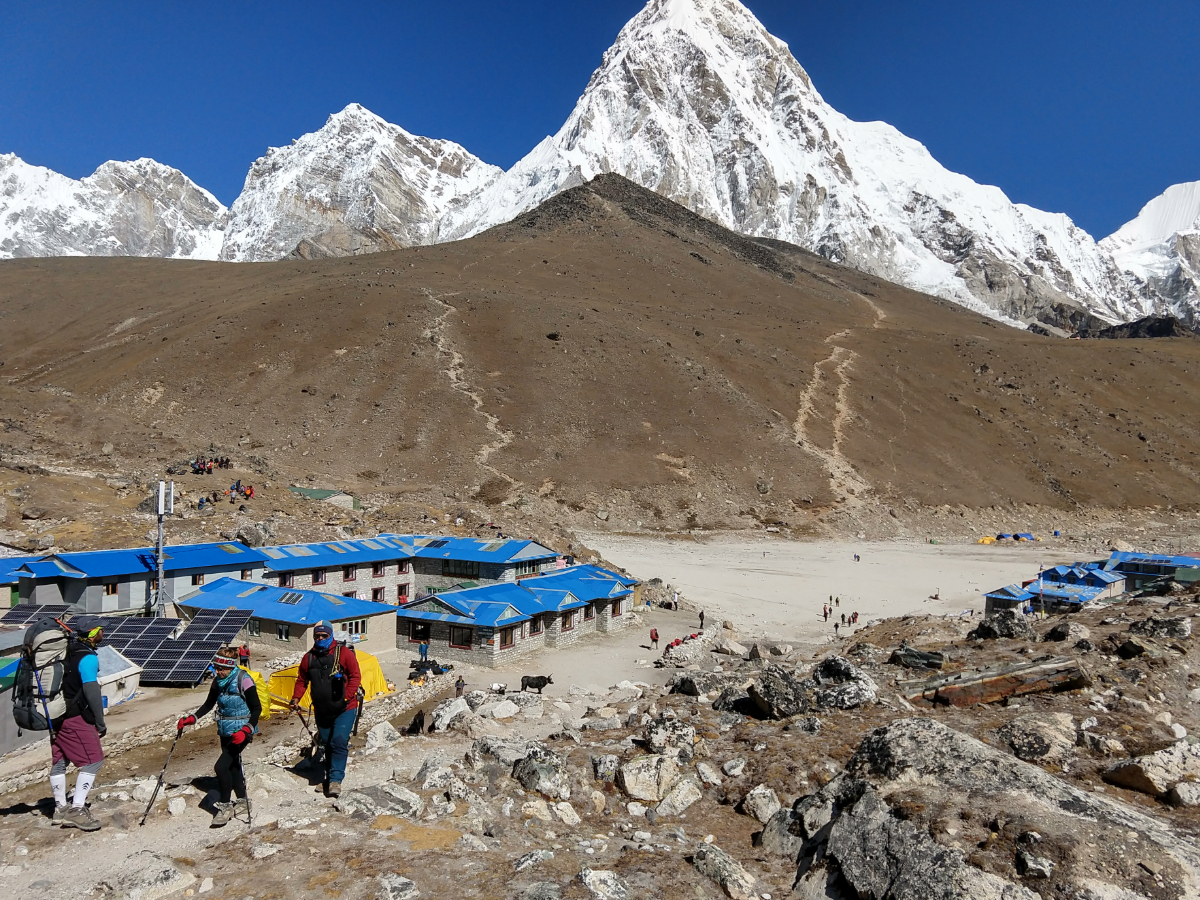
Gorak Shep is your final settlement on the Everest Base Camp trek. You will leave your main bags at your guest house here and carry on to base camp itself, and come back on the same day.
Some tours will take you all the way to Base Camp today, others tomorrow.
Loboche altitude 4,910m, Gorak Shep altitude 5,140m walking distance 4.5 km walk time 3 hours.
We had a phone or wifi signal here, briefly, I got a text from my friend Emma. She was quite surprised to get a text back from Base Camp.
Day 9, Climb Kala Patthar and continue to Everest Base Camp, returning to Gorak Shep
Day 8 and 9 are both about Base Camp. Some people will go to Base Camp on Day 8 of the trek, others on Day 9.
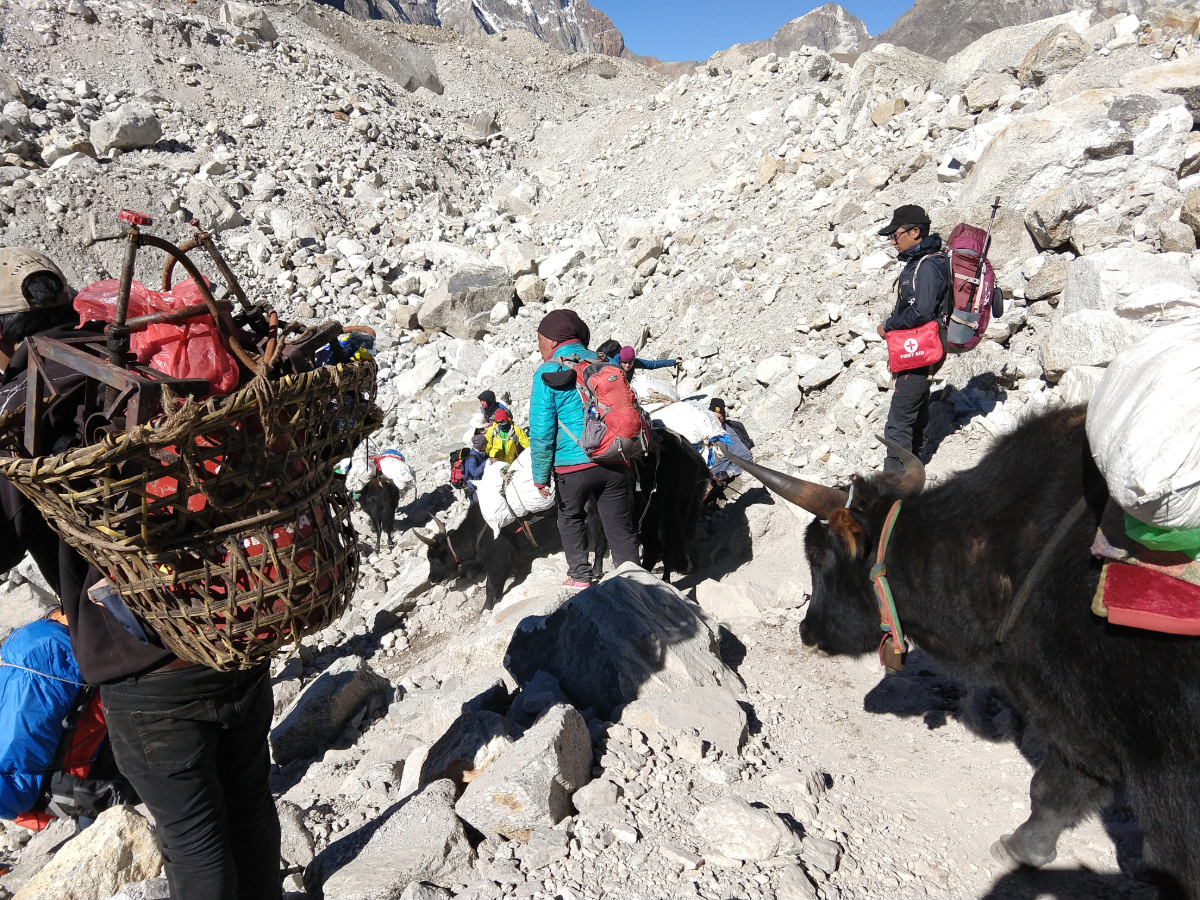
Kala Pathhar is an optional side trek, it’s usual to do it at dawn on Day 9 of the trek.
Once you’ve been to Base Camp, taken a few photos and jostled with the crowds, it’s time to retrace your steps.
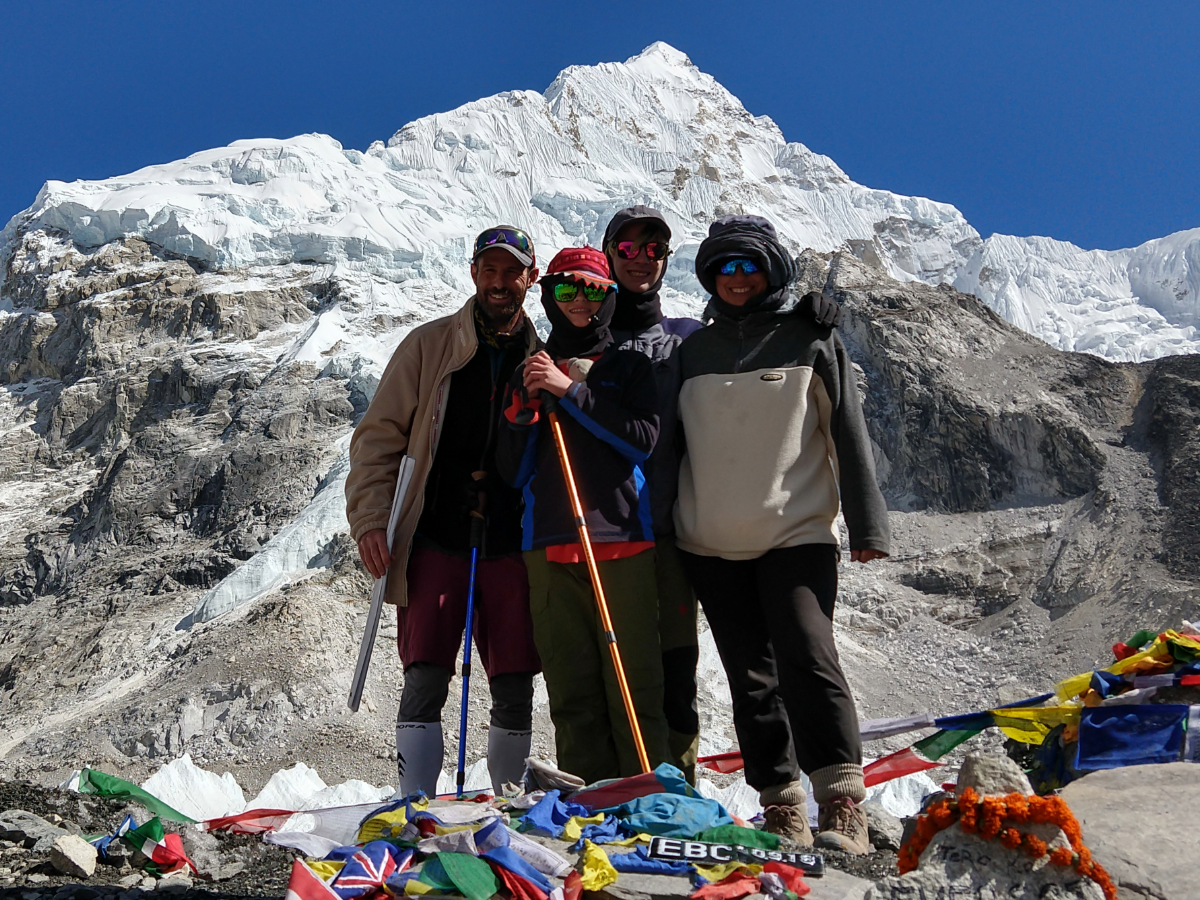
Gorak Shep to Base Camp itself isn’t far, but this is a hard part of the walk because of the uneven rocky terrain and high traffic, there will be a lot of people and animals trying to use one narrow path in both directions. You’ll be feeling the altitude badly, and you have to walk there and back, there’s nowhere to stay at Base Camp. So today will be tough.
Gorak Shep altitude 5,140m Everest Base Camp altitude 5,364m walking distance 3.5 km walk time 3 hours each way.
The total distance of the trek from Lukla to Base Camp is only about 65 km, 40 miles. It’s not a huge distance, it just takes a long time!
Return to Lukla Days 10 – 15.
Some tour groups retrace their steps, some visit Pheriche, Monjo, Pangboche and Kenjuma. Coming back down is faster, and you don’t have to take acclimatisation days.
By day 15 you should be back in Kathmandu.
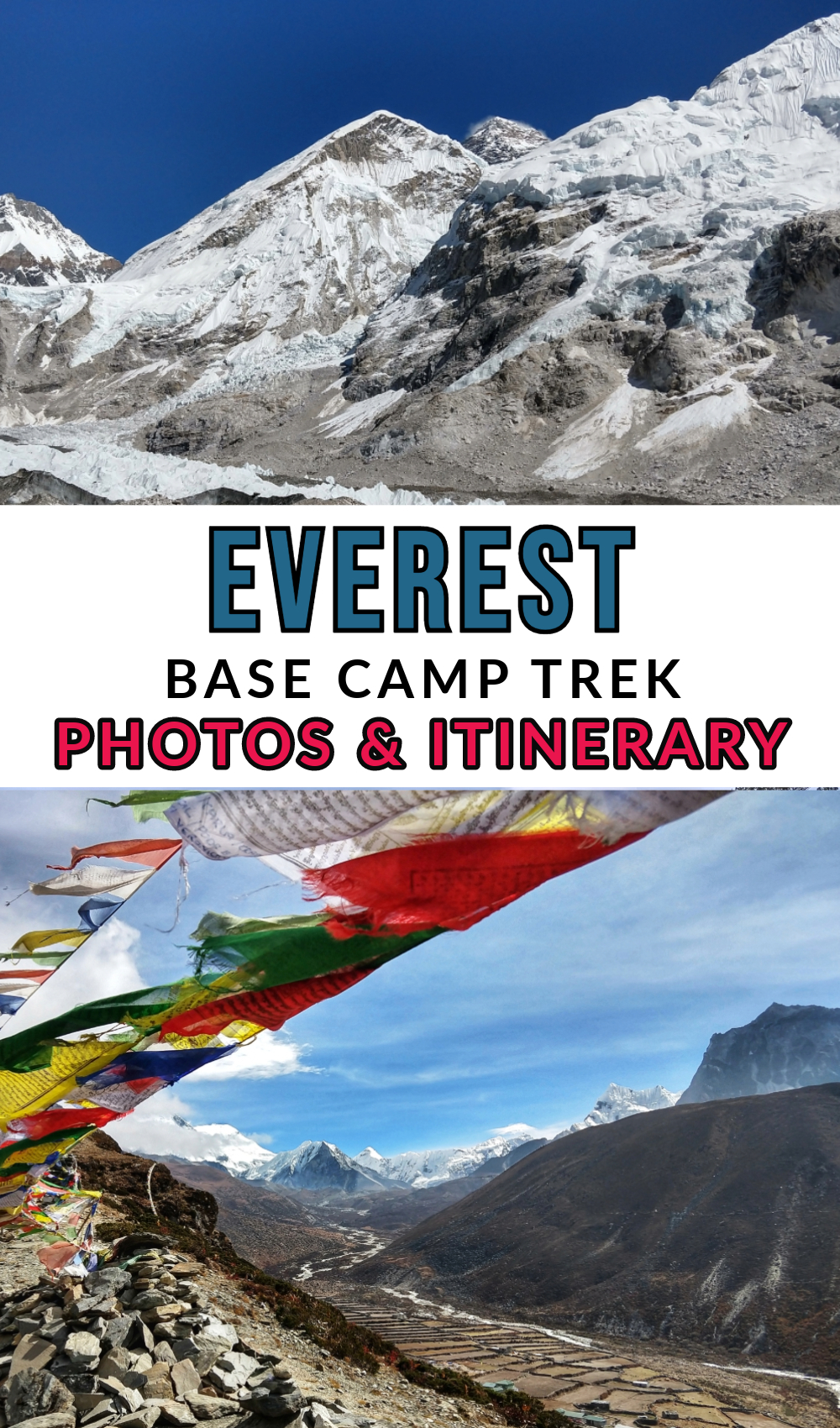
A Three Week Base Camp Trek
When we took our kids to Base Camp we went alone, no guides or porters, and our trek took us 3 weeks. We allowed ourselves days off for sickness, a few extra days in Namche, and some extra acclimatisation days. We also spent a night in Lukla, which isn’t usual on organised treks.
If you go solo you have the freedom to do this, we prefer to trek this way.
We’ve also made side treks to Kumjung and stayed overnight between Namche and Tengboche. If you can avoid the guest houses that the big tour groups use you’ll likely have a nicer (and cheaper) stay.
Walking Back From Lukla
We’ve extended our treks a few times by walking to and from Lukla via Phaplu, taking the bus from Phaplu, or flying to Phaplu. From the EBC trail, just past Lukla, to Phaplu takes about 4 days. The bus from Phaplu back to Kathmandu is extremely hair-raising.
These are good alternatives as you get off the main tourist highway that is the EBC trek. Prices drop significantly too. I can’t give you full details on this page but its all on our site, see the related posts.
I also want to mention that you will probably see no trash at all on the EBC trek. I don’t know how the rumour started that it was a rubbish dump up there, but it’s not.
How Much Extra Time To Spend in Nepal?
How much extra time should you spend in Nepal before and after your Everest Base Camp trek is down to you. How much time do you have? How much time can you take off work? We normally get a 3 month visa for Nepal and spend the full 3 months in the country. I’d say spend as long as you can in Nepal, there’s loads to see and do.
You will need several days to really see and enjoy Kathmandu. Then we’d suggest you add a trip to Pokhara, that will add 3-4 days to your trip, visit Lumbini, Buddha’s Birthplace, or Chitwan to see tigers and rhino. Check out our related posts below for more ideas.
Nepal is a very cheap country to visit, but trekking is expensive. You can stay a long time in Nepal and spend very little, but trekking permits, guides and porters don’t come cheap. Your tour group, if you use one, will probably use more expensive hotels too.
Your trekking gear will probably cost you a fortune too, read our post on trekking gear for Nepal before you put your hand in your pocket.
How To Book a Trek
Here are some different ways to book a trek, in this instance, the Everest Base Camp Trek.
You can simply book flights to Kathmandu and organise everything there. This is our usual method. Use Skyscanner to find bargain flights (follow our instructions in this post). There are trekking agencies al over Kathmandu who can help you with flights, permits, guides, and porters, if you need them.
You can also book an organised group trek with a tour company. This company can arrange a trek for you. 10 Adventures specialise in outdoor and active travel, they’re a good one to check for all adventure activities such as trekking. You will also need specialised insurance for high altitude travel, for that get a free quote here.
What really amused me was that one of our Facebook followers accused us of making all this up and Photoshopping all of the photos. What do you think? Did we do it or not? Can you save this post to Pinterest for us please?
If you have any questions about Nepal and trekking, ask in the comments, we’re here to help.
If you'd like to hire a car during your stay, use this car rental comparison tool to find the best deal!
We also suggest you take a look at this company to get a quote for all kinds of the more tricky adventure or extended travel insurance.
Try Stayz / VRBO for an alternative way to find rentals on homes/apartments/condos in any country!

